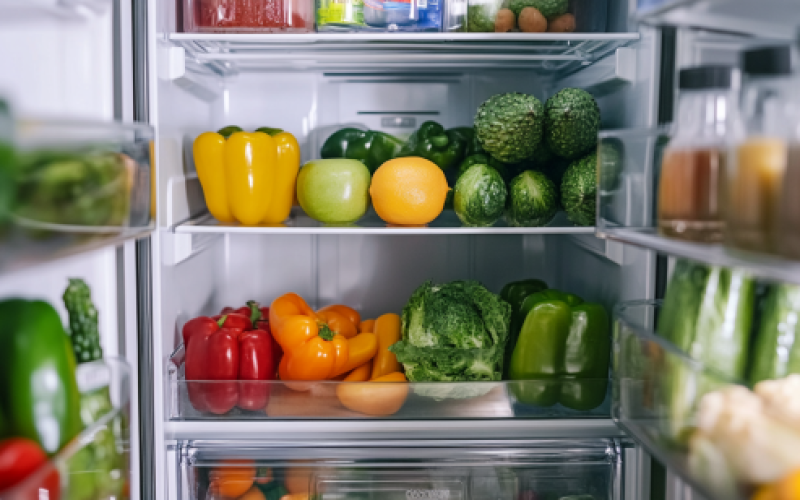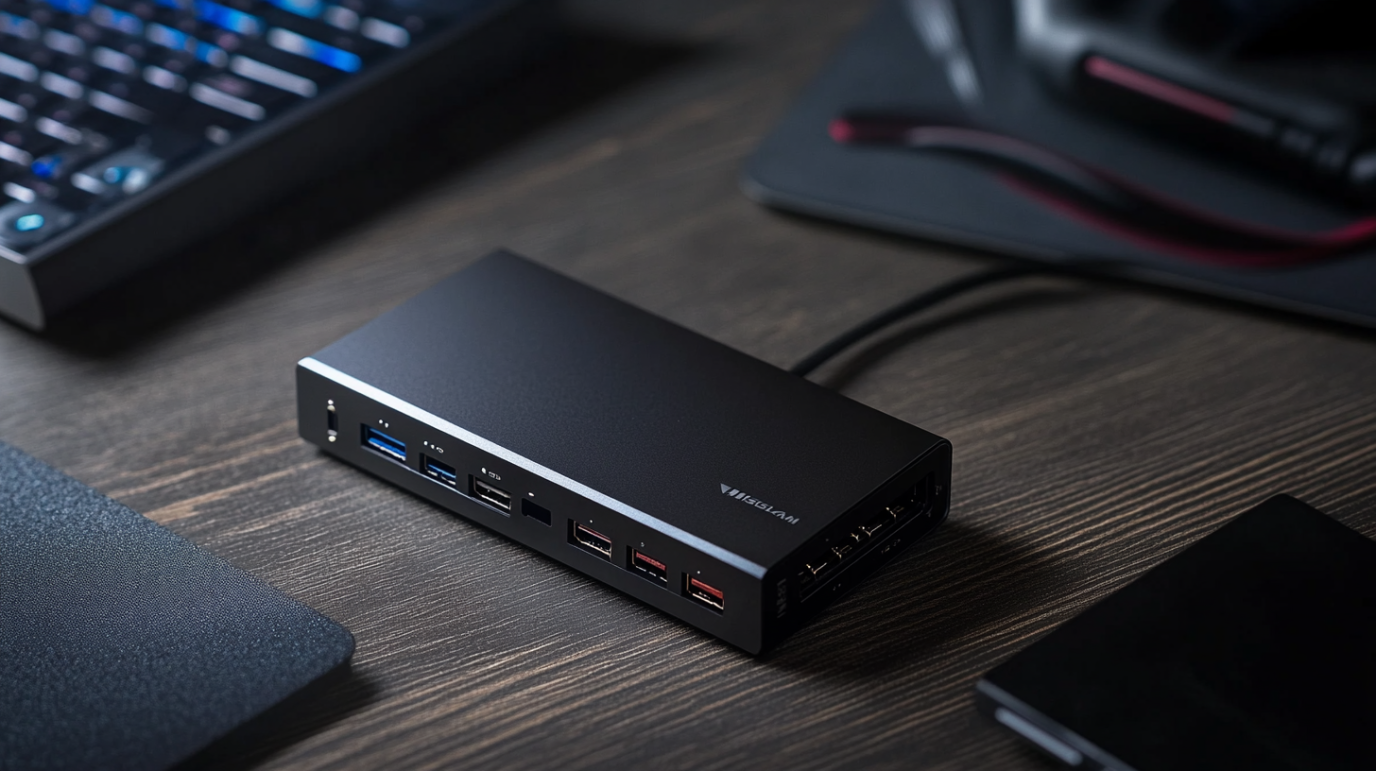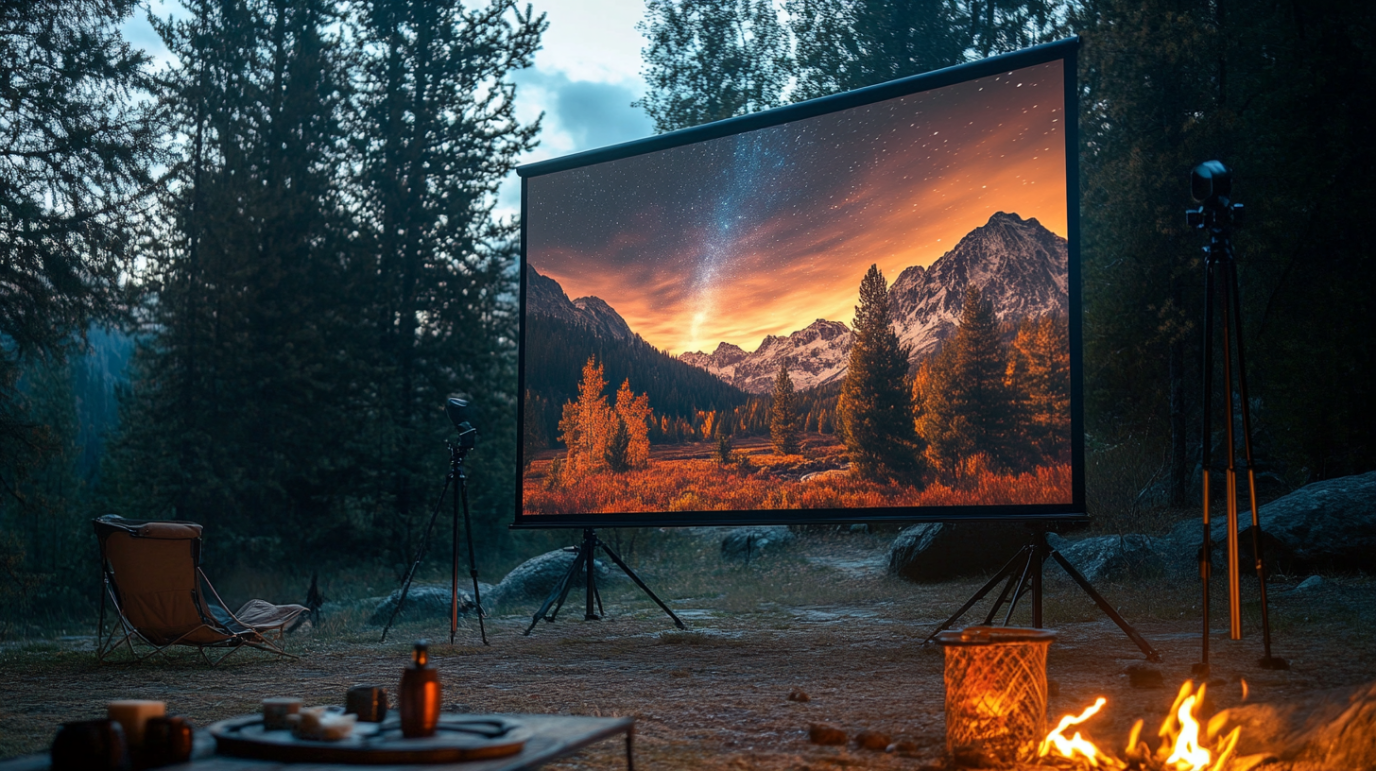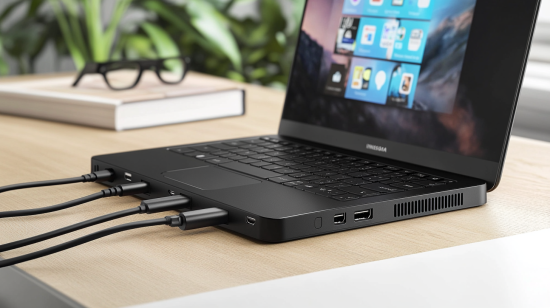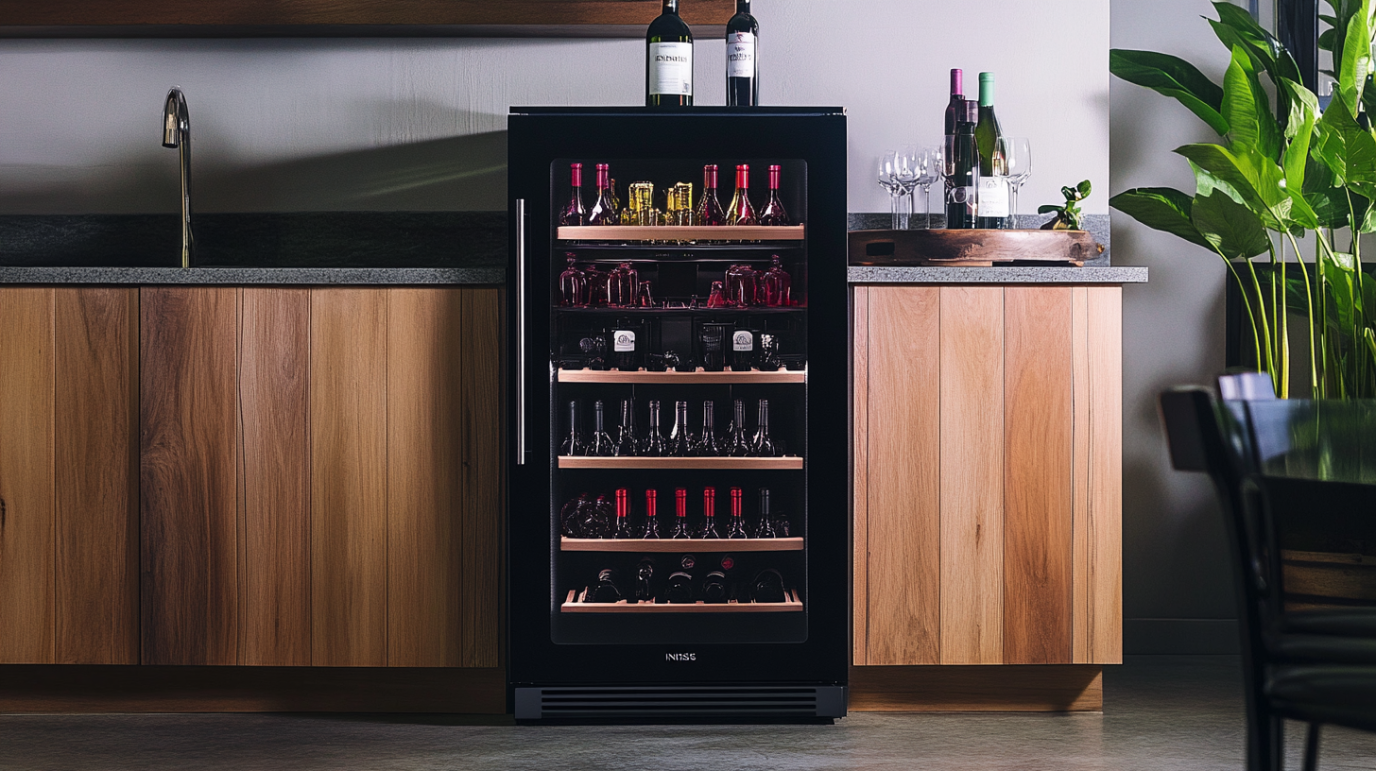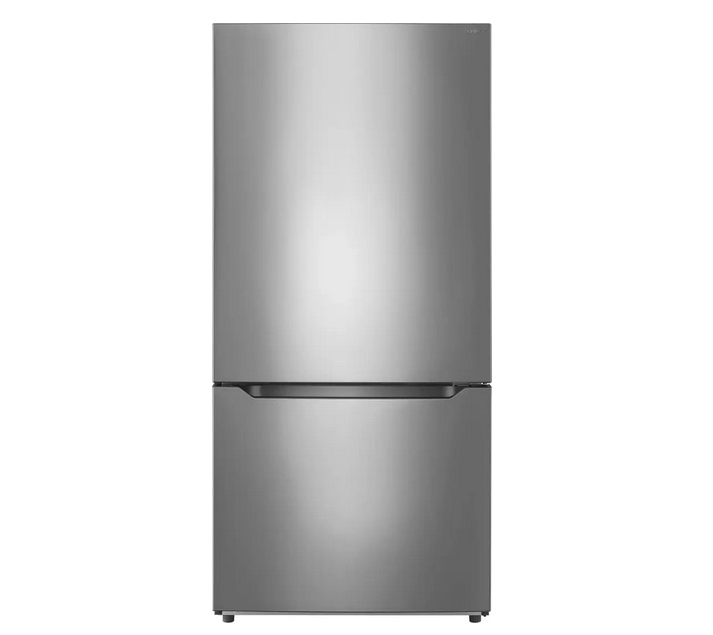
Insignia™ – 18.6 Cu. Ft. Bottom Freezer Refrigerator with ENERGY STAR Certification – Stainless Steel
- 18.6 cu. ft. capacity
- Provides plenty of space for all your essentials and more.
- Versatile placement
- A freestanding design with reversible doors provide flexible placement options.
- Separate bottom freezer
- Separate freezer compartment with two drawers store frozen snacks, entrees and more.
- Optimal fridge storage
- Three glass shelves (one adjustable), two crisper drawers and five door trays in the refrigerator compartment help organize your items.
- LED interior lighting
- Illuminates the food in your refrigerator and freezer, making it easy to see the contents.
- Easy temperature control
- Adjust the temperature of your fridge from 35.6° to 44.6° F (2° to 7° C) or the temperature of your freezer from 8.6 ° to -7.6° F (-13° to -22° C).
- Frost-free design
- Provides outstanding frost maintenance with no need for manual defrosting.
- Stainless steel
- Easy to clean and looks great in your kitchen.
$649.99
Discovering Practical Luxury That Won’t Break the Bank
After years of wrestling with my side-by-side refrigerator that never seemed to have enough space for my pizza boxes and casserole dishes, I finally took the plunge and researched bottom freezer refrigerators. What started as casual browsing turned into a deep dive into the world of Insignia Bottom Freezer Refrigerators. I’m sharing everything I’ve learned so you can make an informed decision without the weeks of research I put in!
When I first started looking into refrigerator options, I had no idea how much my kitchen life was about to improve. If you’re considering an upgrade or replacement, grab your favorite beverage and settle in—this comprehensive guide will walk you through everything you need to know about these practical appliances that have completely transformed my food storage game.
What Exactly Is an Insignia Bottom Freezer Refrigerator?
Let me start with the basics. The Insignia Bottom Freezer Refrigerator is exactly what it sounds like—a refrigerator with the freezer compartment located at the bottom instead of the top or side. But it’s so much more than just a reversed design.
Insignia is Best Buy’s in-house brand that offers affordable yet reliable appliances. Their bottom freezer refrigerators have gained popularity for striking that sweet spot between quality and price. When I first encountered one in my friend’s kitchen, I was immediately struck by how intuitive the layout felt—having the most frequently used fresh food section at eye level just makes sense!
The bottom freezer design revolutionizes how you interact with your food storage on a daily basis. Instead of constantly bending down to reach fresh produce or milk (items I access multiple times daily), I now only bend down when I need something from the freezer (which for me is typically once a day at most).
The design isn’t just about convenience—it’s about rethinking how we use our refrigerators. After living with mine for several months now, I can confidently say that having the refrigerator section at eye level has reduced my food waste because nothing gets “lost” in the back of a bottom shelf anymore.
How Does the Insignia Bottom Freezer Refrigerator Work?
The operation principle is similar to traditional refrigerators, utilizing vapor compression refrigeration technology, but with a thoughtfully redesigned layout. The compressor works to remove heat from inside the unit, maintaining the cool temperatures needed for food preservation.
What impressed me during my research was learning about Insignia’s cooling system. Many models feature multi-air flow technology that maintains consistent temperatures throughout both compartments. This means my leafy greens stay perfectly crisp on every shelf, not just in the dedicated crisper drawers.
The temperature controls are typically located inside the refrigerator section, allowing you to set different temperatures for the fridge and freezer compartments. My model features a digital temperature control panel that makes adjustments incredibly intuitive.
One thing I particularly appreciate is the frost-free operation. Remember those days of manually defrosting your freezer? Those are long gone! The automatic defrost cycle prevents ice buildup, which means more usable space and less maintenance for me.
The freezer drawer slides out smoothly on most models, making it easy to organize and access frozen items. Some higher-end models feature multiple drawers or dividers in the freezer section, which has been a game-changer for organizing my frozen vegetables separate from meats and prepared meals.
Standout Features That Won Me Over
When I was shopping around, certain features of the Insignia Bottom Freezer Refrigerator really stood out from the competition. Here’s what impressed me most:
Adjustable Glass Shelves
The tempered glass shelves can be reconfigured to accommodate items of various heights. Last Thanksgiving, I was able to easily make room for a large turkey by simply adjusting a shelf—something that would have been impossible with my old refrigerator’s fixed shelving.
Humidity-Controlled Crisper Drawers
The specialized drawers maintain optimal humidity levels for fruits and vegetables. I’ve noticed my produce stays fresh significantly longer now, which has actually saved me money on groceries.
LED Interior Lighting
The bright, energy-efficient LED lighting illuminates every corner of the refrigerator. This might seem like a small detail, but it makes a huge difference when I’m searching for ingredients during late-night cooking sessions.
Reversible Door
This feature was particularly important for my kitchen layout. The ability to change the door swing direction meant I could position the refrigerator exactly where I needed it without awkward access issues.
Energy Star Certification
Many Insignia models are Energy Star certified, which means they meet strict energy efficiency guidelines. My electricity bill has actually decreased since upgrading, despite this being a larger refrigerator than my previous one.
Smooth-Glide Freezer Drawer
The freezer drawer extends fully and glides smoothly, making it easy to access items stored at the very back. This has eliminated my “freezer archaeology” sessions where I’d dig through layers of frozen items trying to find something specific.
Gallon Door Storage
The door bins are designed to hold gallon-sized containers, freeing up valuable shelf space. As someone who always has multiple beverages on hand, this feature alone has made a significant difference in my refrigerator organization.
The Cost Factor: Is It Worth the Investment?
Let’s talk numbers. The price range for Insignia Bottom Freezer Refrigerators typically falls between $600 and $1,100, depending on the size, finish, and specific features. This positions them as a mid-range option that’s more affordable than premium brands like Samsung or LG, but with many of the same conveniences.
When I was comparing models, I found that an equivalent bottom freezer refrigerator from a premium brand would cost anywhere from $1,200 to $2,500. That’s a significant difference that made me take a serious look at the Insignia option.
What I’ve discovered after owning mine for some time now is that the value proposition is excellent. The build quality feels substantial, the cooling performance is consistent, and the features match what I’d expect from more expensive brands.
During my research, I learned that Best Buy frequently runs promotions on their Insignia appliances. I managed to snag mine during a holiday sale that included free delivery and installation, bringing the total cost down considerably. It’s worth keeping an eye on their website or signing up for alerts if you’re not in an immediate rush to purchase.
One important consideration is that replacement parts for Insignia appliances are readily available and typically less expensive than those for premium brands. This can significantly reduce repair costs outside of warranty coverage.
Speaking of warranties, most Insignia refrigerators come with a 1-year manufacturer’s warranty, with the option to purchase extended coverage. I opted for the extended warranty for peace of mind, but so far haven’t needed to use it.
Where to Buy Your Insignia Bottom Freezer Refrigerator
As Best Buy’s house brand, Insignia refrigerators are primarily available through Best Buy stores and their website. This exclusivity actually has some advantages—when I was ready to make my purchase, I could view the refrigerator in person at my local Best Buy, then choose whether to take it home that day or schedule delivery.
Best Buy frequently offers free delivery on appliance purchases over a certain threshold, which most Insignia refrigerators easily meet. They also offer installation services and removal of your old refrigerator for an additional fee, which I found well worth the convenience.
During my shopping experience, I discovered that Best Buy also offers price matching if you find the same model for less elsewhere. However, since Insignia is their exclusive brand, this typically only applies to occasional listings on marketplace sites.
If you’re open to a refurbished or open-box unit, Best Buy’s outlet section often has Insignia refrigerators at steep discounts. These units still carry a warranty and have been inspected for functionality, potentially saving you hundreds of dollars.
While I ultimately purchased mine new during a sale, I seriously considered the open-box option and found several units that were returned simply because the customer changed their mind about the finish or size.
Finding the Perfect Fit: Dimensions and Space Requirements
Getting the right size refrigerator for your space is crucial. Insignia Bottom Freezer Refrigerators come in various dimensions to fit different kitchen layouts. The most common sizes range from 24-inch width (apartment-sized) to 30-inch width (standard).
The model I chose is the 30-inch width version, which stands approximately 68.5 inches tall and 31.5 inches deep. Before making my purchase, I carefully measured not only the space where the refrigerator would stand but also the path it would need to travel to reach that location—including doorways and tight corners.
An important consideration that’s often overlooked is ventilation space. These refrigerators require about an inch of clearance on the sides and top for proper air circulation. Ignoring these requirements can lead to inefficient operation and potentially shortened lifespan of the appliance.
The depth is another crucial dimension to consider, especially if you’re aiming for a built-in look. Standard Insignia models are typically around 31-33 inches deep, which means they’ll protrude a few inches beyond standard 24-inch deep countertops. This is common for most refrigerators that aren’t specifically marketed as “counter-depth.”
If a flush installation is important to you, Insignia does offer counter-depth models that align more closely with standard cabinetry, though these generally come with a slightly higher price tag and reduced capacity.
For those with space constraints, the 24-inch wide models offer surprisingly generous capacity considering their compact footprint. I was impressed by how efficiently these smaller units use their interior space.
Energy Efficiency: Saving Money and the Planet
Energy efficiency was high on my priority list, and I was pleased to discover that many Insignia Bottom Freezer Refrigerators are Energy Star certified. This means they meet or exceed federal guidelines for energy consumption.
My model uses approximately 540 kWh per year, which translates to an estimated annual operating cost of about $65 based on national average electricity rates. Compared to my previous refrigerator, which was only about 10 years old, this represents a savings of about $25 annually.
While that might not sound like much, over the expected 12-15 year lifespan of the refrigerator, those savings add up to around $300-$375. Combined with the lower initial purchase price compared to premium brands, the total cost of ownership makes Insignia an economical choice.
The energy efficiency features that contribute to these savings include:
- High-efficiency compressors that adjust their speed based on cooling needs
- Improved insulation that maintains temperatures with less energy
- LED lighting that consumes a fraction of the power of older incandescent bulbs
- Door alarms that alert you if the door is left ajar, preventing cold air loss
I’ve noticed that the refrigerator runs quietly and cycles less frequently than my old unit, which is another indication of its efficiency. The compressor makes a gentle hum when it’s running but is otherwise nearly silent.
Capacity Considerations: How Much Space Do You Really Need?
Insignia Bottom Freezer Refrigerators range in capacity from approximately 10 cubic feet for the smallest models to 18 cubic feet for the largest. When selecting a refrigerator, I found that the general guideline of 4-6 cubic feet per person in your household is helpful.
I opted for a 16.5 cubic foot model for my household of two, which provides ample space for regular groceries plus extra capacity for entertaining. The refrigerator section accounts for roughly 11.5 cubic feet, while the freezer provides about 5 cubic feet of storage.
What impressed me most about the capacity isn’t just the raw numbers but how usable the space is. The organization of the interior makes it feel more spacious than my previous side-by-side model, which technically had more cubic footage but wasted much of it with awkward compartments.
The wide shelves in the refrigerator section easily accommodate large platters and pizza boxes, while the door bins hold multiple gallon containers and tall bottles. The freezer drawer has enough depth to store bulky items like frozen turkeys or multiple ice cream containers.
For larger families or those who entertain frequently, the 18 cubic foot models offer additional capacity without requiring substantially more floor space. The difference is primarily in height, with larger models standing a few inches taller.
One capacity consideration that’s often overlooked is the proportion between refrigerator and freezer space. Bottom freezer models typically allocate about 70% of their capacity to the refrigerator section and 30% to the freezer. If you store a lot of frozen foods, this is something to keep in mind.
Keeping It Clean: Maintenance Made Simple
Maintaining the Insignia Bottom Freezer Refrigerator has been much simpler than I anticipated. The smooth surfaces and removable components make regular cleaning straightforward.
For routine cleaning, I simply wipe down the interior surfaces with a solution of mild dish soap and warm water. The glass shelves can be removed and washed in the sink, which is particularly useful after spills.
The crisper drawers also slide out completely, allowing for thorough cleaning. I’ve found that lining these drawers with paper towels helps absorb excess moisture and makes cleanup even easier.
One maintenance task that’s specific to bottom freezer models is occasionally cleaning the drain hole and drip pan at the back of the freezer compartment. This prevents water buildup during the automatic defrost cycle. It’s a simple task that takes just a few minutes every few months.
The exterior cleaning depends on the finish you choose. My stainless steel model looks best when cleaned with a specific stainless steel cleaner that prevents fingerprints and smudges. For white or black finishes, standard kitchen cleaners work perfectly.
The condenser coils, typically located at the back or underneath the refrigerator, should be vacuumed about twice a year to remove dust and debris. This simple maintenance task helps maintain cooling efficiency and can extend the life of the appliance.
Unlike some refrigerators that require water filter replacements, most Insignia models don’t have built-in water dispensers or ice makers, eliminating this maintenance expense and potential point of failure.
Ice, Ice, Baby: The Scoop on Ice Makers
Most standard Insignia Bottom Freezer Refrigerators do not come with built-in automatic ice makers. Instead, they include ice cube trays that you fill manually. Initially, I was concerned about this, having become accustomed to the convenience of an automatic ice maker in my previous refrigerator.
However, after using the manual ice trays for several months, I’ve found I actually prefer this approach for several reasons:
- More freezer space is available without the ice maker mechanism taking up room
- No risk of ice maker malfunctions or water leaks
- No ongoing costs for water filter replacements
- The ice tastes better when made with filtered water of my choosing
For those who consider an automatic ice maker essential, some higher-end Insignia models do offer this feature as an option. Alternatively, a countertop ice maker is a solution that many of my friends have adopted with great satisfaction.
The freezer compartment provides ample space for storing pre-made ice in bins if you prefer to make larger quantities at once. During summer months or when entertaining, I’ve found that preparing extra ice a few days in advance works perfectly.
If you’re converting from a refrigerator with an automatic ice maker, be aware that you’ll need to disconnect the water line during installation. Best Buy’s installation service can handle this if you opt for professional installation.
Troubleshooting Tips from My Experience
While my Insignia refrigerator has been remarkably reliable, I’ve compiled some troubleshooting tips based on minor issues I’ve encountered and research I’ve done:
Temperature Fluctuations
If you notice inconsistent temperatures, check that the refrigerator has adequate clearance for ventilation and isn’t placed near heat sources like ovens or direct sunlight. Also ensure the door gaskets are clean and sealing properly.
Unusual Noises
Most refrigerators make occasional clicking, gurgling, or humming sounds as part of normal operation. However, if you notice loud or persistent noises, check that the refrigerator is level and that nothing has fallen behind it or underneath it that might be vibrating against the unit.
Excessive Frost Buildup
While these refrigerators are frost-free, excessive frost can occasionally develop if the door is frequently left open or if the door gasket isn’t sealing properly. Inspect the gasket for food debris or damage, and ensure the refrigerator is level so the doors close completely.
Water Under the Crisper Drawers
This is often caused by condensation or items with high water content stored uncovered. Using the humidity controls on the crisper drawers appropriately for the foods you’re storing can help manage moisture levels.
Circuit Trips When Plugged In
Insignia refrigerators should be plugged directly into a dedicated wall outlet, not an extension cord or power strip. If the circuit breaker trips, you may need an electrician to verify that the circuit can handle the refrigerator’s power requirements.
For more serious issues, Insignia’s customer service has been responsive in my experience. Their support team can be reached through Best Buy’s customer service channels, and they maintain a comprehensive database of user manuals and troubleshooting guides online.
Real Talk: What Users (Including Me) Are Saying
After several months of ownership and conversations with other Insignia owners, I’ve gathered a range of perspectives on these refrigerators. The consensus is generally positive, particularly regarding the value proposition.
Many users, myself included, cite the spacious interior and logical organization as major advantages. The bottom freezer configuration receives consistent praise for its practicality, with users appreciating having fresh foods at eye level.
The energy efficiency is another commonly mentioned positive, with many users reporting noticeable decreases in their electricity bills after switching from older refrigerators.
Temperature consistency receives high marks, with foods staying properly chilled throughout the refrigerator compartment. The separate temperature controls for the refrigerator and freezer sections allow for customization based on individual preferences.
On the critical side, some users mention that the freezer drawer can be challenging to organize efficiently without additional bins or dividers. I’ve addressed this by purchasing inexpensive plastic organizers that fit perfectly within the drawer.
A few reviews mention that the initial cool-down period after installation can take 24 hours or more, which is actually standard for most refrigerators but worth noting if you’re planning your grocery shopping around a new installation.
Door bin durability receives mixed reviews, with some users reporting that heavily loaded door bins can sag over time. I’ve found that distributing weight evenly and avoiding overloading these bins prevents this issue.
Overall, user satisfaction seems to correlate strongly with appropriate expectations. Those who understand they’re purchasing a mid-range appliance at an entry-level price point are generally very pleased with the performance and features.
Perfect for Small Kitchens? My Take
Having previously lived in an apartment with a compact kitchen, I can confidently say that Insignia Bottom Freezer Refrigerators offer excellent options for small spaces. The 24-inch width models, in particular, provide a generous capacity despite their narrow footprint.
The bottom freezer configuration actually contributes to space efficiency in compact kitchens. Since the refrigerator section is at eye level, you spend less time with the door open searching for items, which means you can position the refrigerator closer to counters or walls without impeding access.
Several design features make these refrigerators particularly suitable for small kitchens:
- Reversible doors allow for flexible placement
- Flat back design permits installation closer to walls
- Recessed handles on some models prevent protrusion into walkways
- Interior organization maximizes usable space
For studio apartments or truly tiny kitchens, Insignia also offers compact models around 10 cubic feet that provide essential refrigeration without dominating the space.
One consideration for small kitchens is the door swing radius. Measure carefully to ensure you have adequate clearance for the door to open fully, keeping in mind that a fully opened refrigerator door extends beyond the width of the unit itself.
If your kitchen layout requires placing the refrigerator in a corner, opt for a model with reversible doors so you can configure it to open away from the wall, maximizing accessibility.
Warranty Coverage: What’s Protected and for How Long
Standard Insignia Bottom Freezer Refrigerators come with a one-year limited warranty that covers defects in materials and workmanship. This is fairly standard for the industry and provides basic protection during the initial period when manufacturing defects typically emerge.
The warranty includes both parts and labor, which means repairs for covered issues won’t cost you anything during the first year. Best Buy handles warranty service through their Geek Squad technical support team, which I’ve found to be responsive and knowledgeable.
For those seeking additional protection, Best Buy offers extended warranty plans that can cover your refrigerator for up to five years. These plans include benefits like:
- Coverage for mechanical and electrical failures
- Power surge protection
- Food loss reimbursement if the refrigerator fails
- No deductibles or hidden fees
- In-home service for larger appliances
I opted for a three-year extended warranty for about $120, which felt like reasonable insurance for an appliance I expect to use daily for many years. Whether this makes sense for you depends on your comfort with potential repair costs and how long you plan to keep the refrigerator.
One warranty consideration that impressed me is that Insignia’s coverage is transferable if you sell your home or give the refrigerator to someone else. This adds to the overall value proposition, particularly if you’re planning to upgrade your kitchen within a few years.
Comparing Insignia to Other Refrigerator Brands
During my research phase, I compared Insignia Bottom Freezer Refrigerators to similar models from brands like Whirlpool, GE, Samsung, and LG. Here’s how they stack up in key areas:
Price
Insignia consistently offers the best value, with comparable features to mid-range models from major brands but at prices that are typically 20-30% lower. For example, a 16 cubic foot Insignia model priced around $750 offered similar features to Whirlpool and GE models priced at $950-$1,100.
Build Quality
While premium brands may use slightly heavier gauge materials in some components, the overall build quality of Insignia refrigerators is solid. Door hinges, drawer slides, and shelving all feel substantial and well-engineered.
Energy Efficiency
In this category, Insignia performs surprisingly well, with energy consumption ratings comparable to much more expensive models. The Energy Star certification on many models provides independent verification of their efficiency.
Features
This is where some differences emerge. Premium brands often offer advanced features like dual cooling systems, smart home connectivity, or specialized storage zones. However, Insignia includes most essential features that impact day-to-day usability.
Reliability
Based on consumer reports and user reviews, Insignia refrigerators demonstrate reliability on par with other major brands in their price range. The simplified design actually contributes to reliability by eliminating potential failure points like water dispensers and ice makers (in most models).
Warranty
Insignia’s one-year warranty is standard for the industry, though some premium brands offer longer coverage on specific components like the sealed cooling system.
Appearance
While Insignia designs are attractive and modern, they tend toward the functional rather than the cutting-edge. Premium brands often offer more finish options and design flourishes, though these rarely affect performance.
For my needs and budget, Insignia offered the best balance of quality, features, and price. I chose to invest the money saved toward other kitchen improvements rather than paying a premium for features I was unlikely to use.
Customization Options: Making It Your Own
One aspect of the Insignia Bottom Freezer Refrigerator that I appreciate is the ability to customize the interior configuration to suit my specific needs. The adjustable shelves can be positioned at various heights, allowing me to create zones for different types of foods.
The door bins are also adjustable on most models, which lets me configure them based on whether I’m storing gallons of milk, condiment bottles, or beverage cans. This flexibility means the refrigerator adapts to my changing needs throughout the year.
For additional customization, I found that standard refrigerator accessories from other manufacturers often fit perfectly. For example, I added an inexpensive egg holder and a specialized cheese drawer that integrated seamlessly with the existing shelving.
The freezer drawer, while spacious, benefits from additional organization. I purchased affordable plastic bins that fit the dimensions perfectly, allowing me to create separate sections for different types of frozen foods.
Some users report successfully installing aftermarket ice makers in models that don’t come with them pre-installed, though this typically requires professional installation and may affect warranty coverage.
For those concerned about appearance, appliance magnet covers or peel-and-stick vinyl wraps can transform the exterior look of these refrigerators to match various kitchen designs—from retro styles to custom colors that complement your decor.
Finish Options: Beyond Basic White
Insignia Bottom Freezer Refrigerators come in several finish options to match different kitchen aesthetics. The most common finishes include:
Stainless Steel
This popular option offers a modern, professional look that coordinates well with other appliances. The stainless steel finish on Insignia models has a slightly brushed appearance that helps hide fingerprints better than mirror-finish stainless steel.
Black Stainless Steel
For a more contemporary look, some models offer black stainless steel, which provides a sophisticated appearance while being more resistant to visible fingerprints than traditional stainless steel.
White
The classic white finish offers a clean, timeless look that brightens kitchens and tends to show less dust than darker finishes. It’s also typically the most affordable option.
Black
A sleek black finish can create a striking look in many kitchen designs and helps disguise dirt and smudges better than lighter colors.
When selecting a finish, consider not only your current kitchen design but also your cleaning habits and whether you have children who might frequently touch the refrigerator with sticky fingers.
I opted for the stainless steel finish to match my other appliances, but I’ve found it does require regular wiping to maintain its appearance. Specialized stainless steel cleaning wipes have become a staple on my shopping list.
One practical consideration is that darker finishes like black or black stainless steel tend to show scratches more prominently than lighter finishes. If you have a busy kitchen with lots of activity, this might influence your decision.
Longevity: How Long Can You Expect It to Last?
Based on industry data and user experiences, Insignia Bottom Freezer Refrigerators typically have a lifespan of 12-15 years with proper maintenance. This is comparable to other refrigerator brands in the mid-range market segment.
Several factors can influence the lifespan of your refrigerator:
- Regular cleaning of condenser coils
- Proper installation with adequate ventilation
- Avoiding overloading the refrigerator or freezer
- Maintaining consistent power supply (using a surge protector)
- Prompt attention to minor issues before they become major problems
The simplified design of most Insignia models—particularly those without water dispensers or automatic ice makers—contributes to their longevity by eliminating common failure points.
Components most likely to require service over the life of the refrigerator include the compressor, door gaskets, and temperature control systems. Of these, only the compressor represents a major repair cost, typically occurring well beyond the initial warranty period if at all.
Many users report their Insignia refrigerators performing reliably well beyond the expected lifespan, particularly when maintained properly. The key to maximizing longevity seems to be regular cleaning and avoiding overloading the unit.
Installation Insights: What to Expect
Installing an Insignia Bottom Freezer Refrigerator is straightforward, especially if you’re replacing an existing refrigerator of similar size. However, there are several considerations to ensure optimal performance:
Delivery and Placement
Most full-size refrigerators won’t fit through doorways while fully assembled. The delivery team will typically remove the doors for transport and reinstall them at your location. Ensure pathways are clear and measure all doorways and corners along the delivery route.
Leveling
Proper leveling is crucial for door alignment and drainage. Most models include adjustable feet that can be raised or lowered to achieve perfect leveling, even on slightly uneven floors. The refrigerator should tilt back very slightly to ensure doors close automatically.
Power Requirements
Insignia refrigerators require a properly grounded, dedicated 120-volt circuit. Avoid using extension cords or power strips, as these can compromise performance and pose safety risks.
Clearance
Allow at least 1 inch of space on the sides and top, and 2 inches at the back for proper air circulation. Inadequate ventilation can cause the compressor to work harder, reducing efficiency and potentially shortening the appliance’s lifespan.
Initial Startup
After installation, allow the refrigerator to run for 24 hours before fully stocking it with food. This gives the cooling system time to stabilize at the proper temperatures. During this period, you might notice more frequent cycling or operational sounds, which is normal.
If you opt for professional installation through Best Buy, the service typically includes removal of packaging materials, installation of any components that were removed for shipping, leveling, and basic operational testing. For an additional fee, they can also remove your old refrigerator.
For those comfortable with DIY installation, the process is manageable with two people to handle the weight and bulkiness. The user manual provides detailed instructions specific to your model.
Temperature Control: Getting It Just Right
Insignia Bottom Freezer Refrigerators offer precise temperature control for both the refrigerator and freezer compartments. Most models feature either digital controls or traditional dial controls, depending on the specific model and price point.
The recommended temperature settings are:
- Refrigerator section: 37-40°F (3-4°C)
- Freezer section: 0°F (-18°C)
These settings provide safe food storage while maximizing energy efficiency. The temperature controls are typically located inside the refrigerator section, either on the back wall or along the top edge.
Digital control models offer precise temperature adjustments and usually display the current temperature. Some models feature an alarm that sounds if the door is left open or if the internal temperature rises above safe levels.
Models with traditional dial controls use a numerical scale (typically 1-7) rather than specific temperatures. In these models, a higher number corresponds to a colder setting. Finding the optimal setting may require some adjustment based on your usage patterns and ambient kitchen temperature.
I’ve found that seasonal adjustments are sometimes necessary, with slightly colder settings required during summer months when the refrigerator door is opened more frequently and the kitchen tends to be warmer.
One temperature management tip I’ve discovered is to avoid placing hot leftovers directly into the refrigerator. Allowing foods to cool slightly (but not for more than two hours) before refrigerating helps maintain consistent internal temperatures and reduces energy consumption.
The multi-air flow cooling system in many Insignia models helps maintain consistent temperatures throughout the refrigerator, eliminating warm spots that can lead to premature food spoilage.
Final Thoughts: Is the Insignia Bottom Freezer Refrigerator Right for You?
After living with my Insignia Bottom Freezer Refrigerator for several months and researching extensively for this guide, I can confidently recommend these appliances for many households. They offer an impressive combination of practical features, reliable performance, and affordable pricing.
The bottom freezer configuration has genuinely improved my kitchen workflow, with everyday items at eye level and less frequently used frozen foods stored below. This intuitive arrangement aligns perfectly with how most people actually use their refrigerators.
For families on a budget who don’t want to compromise on quality, Insignia represents an excellent value proposition. The money saved compared to premium brands can be substantial without sacrificing essential features or reliability.
The energy efficiency of these refrigerators contributes to long-term savings, making them even more economical over their lifespan. The simplified design—particularly in models without ice makers or water dispensers—reduces potential points of failure.
That said, these refrigerators may not be ideal for everyone. If you’re looking for cutting-edge features like smart home integration, door-in-door access, or custom temperature zones, you may need to look at more premium brands and be prepared to pay accordingly.
The bottom line: Insignia Bottom Freezer Refrigerators deliver practical luxury at an accessible price point, making them an outstanding choice for value-conscious consumers who prioritize functionality and reliability.
Whether you’re furnishing your first home, replacing an aging refrigerator, or outfitting a rental property, these refrigerators deserve serious consideration. My experience has been overwhelmingly positive, and based on the research I’ve conducted, many other owners feel the same way.
Have you made the switch to a bottom freezer configuration? I’d love to hear about your experiences and any tips you might have for making the most of these practical appliances!

